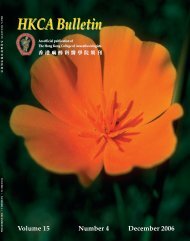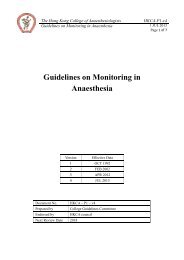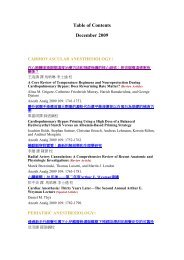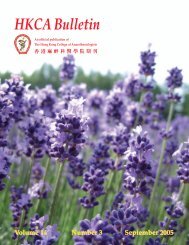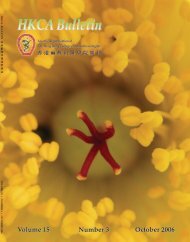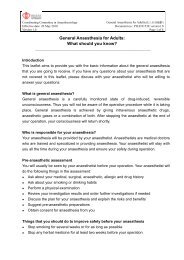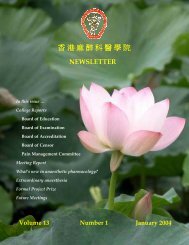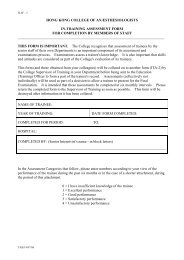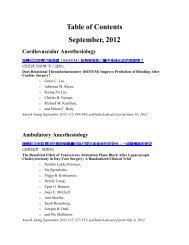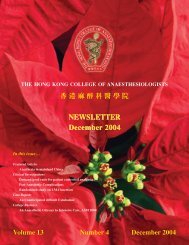Bull HK Coll Anaesthesiol Volume 14, Number 2 <strong>July</strong> <strong>2005</strong>Low‐dose Subcutaneous Ketamine Infusion: a Dose FindingStudy for Post‐operative Analgesia1Derek LS Chan, 2 Tommy KL Suen, 3 Anne KwanDepartment <strong>of</strong> Anaesthesia, United Christian Hospital, <strong>Hong</strong> <strong>Kong</strong>SUMMARYIn this double‐blinded, randomized controlled trial we determined the optimal dose <strong>of</strong> subcutaneousketamine infusion required for post‐operative analgesia after major abdominal surgery. Patients wererandomly allocated to receive either 0.9% saline or one <strong>of</strong> three ketamine doses (0.05, 0.1, 0.2 mg/kg/h),given as subcutaneous infusion. All patients were given intravenous morphine for postoperativeanalgesia using the patient‐controlled analgesia pump. A total <strong>of</strong> 50 patients completed the study. Fivepatients (one had ketamine 0.05 mg/kg/h; 2 received 0.1 mg/kg/h and 2 had 0.2 mg/kg/h) developedsevere psychomimetic adverse reactions that significantly compromised their safety. Postoperatively,there were no differences among groups in subjective assessment <strong>of</strong> analgesic efficacy, pain scores at restand on movement, opioid consumption and other adverse reactions. We observed a trend <strong>of</strong> lower PCAmorphine consumption among the ketamine groups. We concluded that the use <strong>of</strong> low‐dosesubcutaneous ketamine infusion for post‐operative analgesia is not recommended until furtherinformation regarding side effects pr<strong>of</strong>ile is available.Keywords: Ketamine, Patient controlled analgesia, Anesthesia, Dose finding studyBull HK Coll Anaesthesiol <strong>2005</strong>;14:83‐9Ketamine is a well know anesthetic agentfor over three decades. It has analgesicproperties at sub‐anesthetic doses. 4‐12,14,16This is related to a non‐competitive antagonism1MBBS, BSc(Med), FANZCA, FHKCA, FHKAM(Anaesthesiology), Associate Consultant; 2 MBBS,FANZCA, FHKCA, FHKAM (Anaesthesiology),Senior Medical Officer; 3MB BS, FANZCA,FHKCA, Dip Pal Med, Dip Pain Mgt (HKCA)FHKAM (Anaesthesiology), Dip Epi & Biostat, DipAcup, M Pal Care, Consultant and Chief <strong>of</strong> Service.Department <strong>of</strong> Anaesthesia, United Christian Hospital.Address correspondence to: Dr Derek Chan,Department <strong>of</strong> Anaesthesiology and OperatingServices, Alice Ho Miu Ling Nethersole Hospital, TaiPo, NT. E‐mail: dlschan@yahoo.com.hk83at the N‐methyl‐D‐aspartate (NMDA) receptorat the level <strong>of</strong> spinal cord dorsal horn. 1‐3 NMDAreceptors have an important role in thedevelopment <strong>of</strong> wind‐up phenomenon andlong‐term central sensitization <strong>of</strong> the painpathway. 2<strong>The</strong> use <strong>of</strong> sub‐anesthetic, low doseketamine as an analgesic has been investigated.Several reports have produced positive results,without the occurrence <strong>of</strong> dose‐dependentpsychomimetic side effects. 4,5,17,18 Effects oncardiovascular and respiratory systems are alsominimal at this range <strong>of</strong> doses. 4,5,7,10,12,17,18 <strong>The</strong>reported analgesic efficacy is comparable to that<strong>of</strong> morphine and pethidine without the commonside effects such as respiratory depression, 5,8,11,12
Bull HK Coll Anaesthesiol Volume 14, Number 2 <strong>July</strong> <strong>2005</strong>urinary retention, sedation, pruritus andtolerance. 4,13 <strong>The</strong> incidence <strong>of</strong> nausea andvomiting is less than or equal to that <strong>of</strong>opioids. 4,13 When used as an adjunct, ketaminehas an opioid‐sparing effect. 4 A ketaminesubcutaneous infusion <strong>of</strong> 0.1 mg/kg/h has beenshown to produce similar analgesic efficacy as amorphine infusion <strong>of</strong> 0.03 mg/kg/h subcutaneously.5 In this regard, adequate analgesiawith fewer side effects will result in quickerrecovery and fewer complications. Thus, in thelong run, ketamine administration shouldreduce costs and potentially opioid tolerance,dependence, and chronic pain syndrome.Various routes <strong>of</strong> administration, includingsubcutaneous, have been examined and areeffective in providing analgesia. However, theoptimal dose range <strong>of</strong> subcutaneous ketamineinfusion for analgesia has not been found.Subcutaneous infusion is simple to administerand does not require an intravenous access. Thisstudy aims to provide clinicians withinformation on a useful alternative or adjuvantto postoperative analgesia.MethodsAfter obtaining hospital ethics committeeapproval, patients admitted for electiveabdominal surgery involving a midline incisionwere invited to participate if they had chosen IVpatient controlled analgesia (PCA) for postoperativepain relief. With written, informedconsent, 50 patients were randomly allocatedinto four groups receiving either 0.9% saline(Group S) or one <strong>of</strong> three ketamine doses (0.05,0.1 and 0.2 mg/kg/h, Group Ket 0.05, Ket 0.1,and Ket 0.2, respectively) given as asubcutaneous infusion. All patients wereprovided with PCA morphine. <strong>The</strong> pumps wereprogrammed to deliver morphine 1 mg bolus,lockout interval <strong>of</strong> 8 min and 4 hourly limit <strong>of</strong>0.25 mg/kg. Premedication was not prescribed.General anesthesia consisted <strong>of</strong> induction withthiopentone, maintenance with is<strong>of</strong>lurane in70% nitrous oxide/oxygen mixture. Trachealintubation and intra‐operative paralysis werefacilitated by either atracurium, cisatracurium orrocuronium. We gave morphine and/or fentanylfor intraoperative analgesia. <strong>The</strong> actual conduct84<strong>of</strong> anesthesia was left to the discretion <strong>of</strong> theattending anesthetists. A subcutaneous bolus <strong>of</strong>ketamine (0.2 mg/kg) was given immediatelyprior to the infusion while patients in the groupS received equivalent volume <strong>of</strong> 0.9% normalsaline. <strong>The</strong> infusion was commencedimmediately after induction <strong>of</strong> generalanesthesia prior to surgical incision. <strong>The</strong> anteriorchest wall was used as the infusion site becauseit caused minimal interference with the surgeryand provided easy access for inspection andreposition during study period. <strong>The</strong> infusionwas given via a 25G subcutaneous infuserneedle <strong>of</strong> known volume, and the syringe drivenby a syringe pump (Terumo Corporation, Tokyo,Japan). List anesthetists, recovery room nurses,ward staffs, and patient assessors were blindedto the treatment used.Data collection was started at induction <strong>of</strong>general anesthesia and lasted for 72 hours aftercommencement <strong>of</strong> PCA use. Ketamine wasinfused for the first 48 hours. Ward nursesexperienced in looking after continuousinfusions and PCA pumps monitored thepatients. Patients suffering from nausea andvomiting were treated with metoclopramide 10mg IVI, as requested and those showingpsychomimetic symptoms were treated withdiazepam 2 mg IVI every 8 hours, as indicated.Patient demographic data were recorded.Intraoperative data included type and duration<strong>of</strong> surgery, length and dermatomal range <strong>of</strong>incision, and total opioid dose. Recovery dataincluded length <strong>of</strong> hospital stay, total opioiddose. Pain scores were recorded using a 11‐pointverbal rating scale (VRS: 0 = no pain, 10 = worstpain imaginable) at rest and on movement.Postoperatively, 2 hourly nursing observationsincluding pain scores, sedation scores (0 = alert,4 = unarousable), presence <strong>of</strong> nausea, vomiting,PCA consumption, volume <strong>of</strong> study druginfused, heart rate, arterial pressure, respiratoryrate, and pulse oximetry reading. <strong>The</strong> acute painservice also assessed the patients twice daily forthe presence <strong>of</strong> hallucination, vivid dreams, andother psychomimetic side effects such asparanoia and delusion. At the end <strong>of</strong> the 48‐hourinfusion, patient were asked to give asatisfactory score <strong>of</strong> the effectiveness <strong>of</strong>




